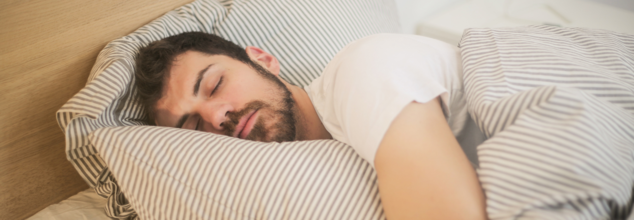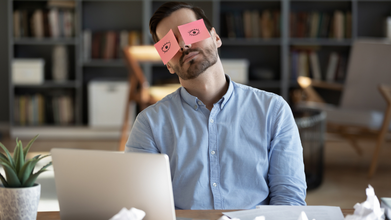- Health Conditions A-Z
- Health & Wellness
- Nutrition
- Fitness
- Health News
- Ayurveda
- Videos
- Medicine A-Z
- Parenting
10 Sleep Hygiene Tips That Will Help You Sleep Better

Sleep hygiene (Credit-Canva)
Sleep hygiene refers to healthy habits that can improve your sleep quality. By following these 10 tips, you can create a conducive environment for better sleep and improve your overall well-being. These tips address various factors that can affect sleep, such as your sleep environment, daily routine, and stress management. By incorporating these sleep hygiene practices into your lifestyle, you can promote restful sleep and wake up feeling refreshed and rejuvenated.
Tips to Help You Sleep Better
There can be many reasons as to why you may not be sleeping properly, whether it is your eating habits or exercise routine. Reach out to a healthcare professional if you are unable to sleep for extended periods of time.
Stick to a Consistent Sleep Schedule
One of the most important factors in improving sleep quality is maintaining a consistent sleep schedule. Try to go to bed and wake up at the same time every day, even on weekends. This helps regulate your body's internal clock, making it easier to fall asleep and wake up at the right times.
Create a Relaxing Bedroom Environment
Your bedroom should be a peaceful and inviting space that promotes relaxation. Ensure your bedroom is dark, quiet, and cool. Invest in comfortable bedding and avoid electronic devices in bed, as the blue light emitted from screens can interfere with sleep.
Limit Screen Time Before Bed
The blue light emitted from electronic devices can suppress the production of melatonin, a hormone that regulates sleep. Avoid using screens for at least an hour before bed. If you must use electronic devices, consider using blue light filtering glasses or apps.
Establish a Relaxing Bedtime Routine
Developing a relaxing bedtime routine can help signal to your body that it's time to wind down and prepare for sleep. Engage in calming activities before bed, such as reading a book, taking a warm bath, or practicing relaxation techniques like deep breathing or meditation.
Avoid Heavy Meals and Caffeine Before Bed
Eating a heavy meal close to bedtime can disrupt sleep as your body focuses on digestion. Avoid consuming caffeine (found in coffee, tea, and soda) several hours before bed, as caffeine can interfere with sleep.
Manage Stress Effectively
Unresolved stress can make it difficult to fall asleep and stay asleep. Practice stress management techniques like meditation, deep breathing, or yoga to reduce anxiety and promote better sleep.
Limit Alcohol and Nicotine
Excessive alcohol or nicotine consumption can disrupt sleep patterns and lead to poor sleep quality. If you smoke, try to quit or reduce your intake.
Avoid Naps During the Day
While short naps can be beneficial, long naps can interfere with nighttime sleep, especially if taken late in the afternoon or evening. If you need to nap, limit it to 30 minutes or less.
Get Regular Exercise
Regular physical activity can improve sleep quality, but avoid intense workouts close to bedtime. Aim for at least 30 minutes of moderate-intensity exercise most days of the week.
Consult a Doctor if Needed
If you're still struggling with sleep despite following these tips, consult a healthcare professional to rule out any underlying medical conditions that may be affecting your sleep.
Not Boarded Any Flight And Still Monday Feels Like A Jetlag? You Are Not Alone

Credits: iStock
It is Monday morning and your alarm rings at 6am. You hit snooze at least twice and feel why weekends are so short. A little bit rewind to two days back, Friday night after work, you did some binge watching and slept till noon on Saturday and again woke up late on Sunday. By evening, you finally felt like a human and again in a few hours, Monday came in. Your body, still confused, groggy, and also a slightly resentful. You feel like you are jetlagged even though you have not even boarded a flight.
This is not laziness or poor discipline, this is social jetlag. Many Indians are living through it. Many of us have two sleep times. One for weekdays and one for the weekends and if you are on a roaster, then your sleeping time adjusts according to your off-days. But the truth is you are not sleeping enough at least for the five days you work and make up for it on your off days. This is what scientists call a social jet lag and it is raising long-term health risks.
What Exactly Is Social Jetlag?
A 2012 study by Till Roenneberg explains that the term 'social jetlag' refers to the mismatch between your biological clock and your social clock. Your biological clock is governed by circadian rhythms, internal processes that decide when you feel sleepy or alert. Your social clock is set by work timings, school schedules, household responsibilities, and social expectations.
Most people sleep earlier and wake up earlier on weekdays because they have to. On weekends, they sleep later and wake up later to recover lost sleep. Researchers describe this as similar to flying across time zones and back every week, except your environment does not change. The sun rises at the same time, but your sleep does not.
Studies suggest that nearly 80 percent of people experience some degree of irregular sleep by shifting sleep times between weekdays and weekends. This pattern has become common due to artificial lighting, late-night screen exposure, and work schedules that are misaligned with natural circadian preferences.
Modern Life Makes It Worse, Here's Why
Artificial light has quietly changed how humans interact with night and day. Evening exposure to bright lights from phones, televisions, and laptops delays the body’s internal clock. This makes it harder to fall asleep early, even when you need to wake up early the next morning.
Over time, this weakens the natural cues that tell the body when it is time to rest and when it is time to be active. Researchers note that this effect creates more late chronotypes, people who naturally feel alert later at night. Unfortunately, most school and office schedules still reward early risers.
The result is a repeated pattern of sleep restriction during weekdays and catch-up sleep on weekends. Unlike travel jetlag, which resolves once the body adjusts to a new light-dark cycle, social jetlag does not correct itself. The solar cycle stays the same, while sleep timing keeps shifting back and forth.
Light is the primary driver of circadian rhythm. In the morning, exposure to sunlight tells the brain to stop producing melatonin, the hormone that makes us sleepy so we feel alert and ready for the day. By evening, melatonin production rises, pushing us toward rest. Night shifts turn this cycle upside down. Instead of winding down, the body is forced to stay active at the very hours it is wired for repair and recovery.
This constant mismatch creates what scientists call 'social jetlag. Your body never gets used to it, because it runs on an internal clock and this is why despite working the same shifts for years, you feel confused.
Indians Are Sleeping Way Less
Data from India paints a worrying picture. A nationwide LocalCircles survey found that 55 percent of Indians get less than six hours of uninterrupted sleep each night. This is an increase from 50 percent the year before, showing that sleep deprivation is getting worse, not better.
Among the reasons cited were late bedtimes combined with early household responsibilities, frequent nighttime awakenings, environmental noise, mosquitoes, and medical conditions like sleep apnea. Even those who spend enough time in bed often experience fragmented sleep.
Wearable sleep data tells a similar story. Fitbit’s global sleep analysis placed Indians as the second most sleep-deprived population after Japan. On average, Indians sleep just over seven hours a night, nearly 50 minutes less than users in the UK and significantly less than Americans. Indians also get the lowest amount of REM sleep globally, a stage critical for memory, emotional regulation, and mental health.
Social jetlag is especially pronounced among adolescents and young adults. Research consistently shows that teenagers naturally shift toward later sleep and wake times due to developmental changes. However, early school start times force them to wake up before their biological clocks are ready.
Late chronotypes accumulate sleep debt during the week and try to repay it on weekends. This pattern has been linked to higher body mass index, metabolic issues, daytime sleepiness, and poorer academic performance. Living against the clock, researchers suggest, may be quietly contributing to the rising burden of obesity and mental health concerns.
In India, academic pressure, coaching classes, screen use, and reduced parental control over sleep schedules only amplify this misalignment.
Social Jet Lag Is Not Just About Feeling Tired, It Has Grave Health Impact
Hormones take the first hit. Our body gets confused on how to regulate melatonin, which is a sleep hormone and cortisol, which is the wake up hormone. It also reduces appetite suppressing hormone leptin, while turning up the hunger hormone ghrelin. This is why you feel the midnight munchies. Chronic sleep deprivation could also lead to prediabetics, as increasing sugar cravings make it difficult for people to prioritize healthy eating.
Studies have associated it with increased risks of obesity, metabolic syndrome, and mental health disorders. It has also been linked to lower productivity, reduced concentration, and mood disturbances.
Addressing social jetlag requires more than sleep tips. Experts suggest later school start times, flexible work hours, reduced evening light exposure, and greater awareness of circadian health. Small changes, like maintaining similar sleep timings on weekdays and weekends, can help, but they cannot fully solve a systemic problem.
Until then, millions of Indians will continue waking up exhausted, wondering why rest feels so elusive.
Covid Symptoms Still Showing Up? Researchers Suggest Other Pathogens May Play A Role

Credits: iStock
COVID symptoms still there? For many people, long COVID is a reality. They continue to live with symptoms like breathlessness, fatigue, and brain fog. To understand this better and why does this continue to persist, a team of microbiologists now have uncovered an important clue. The findings are published in eLife. The researchers suggest that co-infections acquired before or during the bout of COVID could lead to these long-lasting symptoms.
These additional infections have occurred alongside the SARS-CoV-2 and have continued to stay. Maria Laura Gennaro, a microbiologist at Rutgers New Jersey Medical School says, "This is an aspect of long COVID that is not talked about a lot," on the impact of other pathogens on continuous COVID symptoms.
Long COVID Affects Millions
Long COVID has affected around 400 million people from around the world and it has created problems from mild disruptions to severe disability. The research suggests that it can impact the brain, heart, lungs, and even the digestive system.
The new review pulls together existing research and expert insights to spotlight a factor that has largely flown under the radar: infections other than the coronavirus itself may be playing a significant role.
Also Read: Flu Vs Covid: This ONE Key Symptom Will Help You Tell Them Apart, According To Doctor
Other Pathogens That Impact Long Covid
A growing body of evidence points to the Epstein-Barr virus (EBV), best known for causing mononucleosis. Nearly 95 percent of adults carry EBV in a dormant state, where it usually stays quiet unless the immune system is stressed. Infections like COVID can trigger its reactivation.
An early study found that about two-thirds of people with long COVID showed signs of recent EBV activity, with higher antibody levels seen in those reporting more severe symptoms. Later research has linked EBV reactivation to common long COVID complaints, such as persistent fatigue and brain fog.
Another infection drawing attention is tuberculosis, or TB. Around one in four people worldwide carry latent TB. Some evidence suggests that COVID can reduce the immune cells that normally keep TB in check, increasing the chances of reactivation. The link may also run both ways, as TB has been shown to worsen COVID outcomes in some cases.
Researchers stress that timing matters. Infections that occur before COVID may already weaken the immune system. Those that happen during the initial illness could add to tissue damage. Infections that emerge after recovery may take advantage of the immune disruption that COVID leaves behind.
Rising Infections and the Idea of “Immunity Theft”
The authors note that 44 countries have reported tenfold increases in at least 13 infectious diseases compared with pre-pandemic levels. They discuss a concept known as immunity theft, which suggests that an acute COVID infection may leave people more vulnerable to other infections.
If co-infections are found to play a role in long COVID, existing treatments could offer some help. Antibiotics and antivirals already in use might be repurposed to target specific infections. Clinical trials could then test whether treating these infections eases long COVID symptoms.
A Hypothesis Still Under Review
The researchers are careful to point out that this idea is still at an early stage. While the links they describe make biological sense, they have not been proven. No direct cause-and-effect relationship has yet been established between any co-infection and long COVID.
As one researcher put it, correlation does not equal causation. Proving the theory would require large population studies and animal research, which is challenging due to the lack of reliable animal models for long COVID.
Delhi Is a Gas Chamber Where Nothing Comes In or Goes Out, Says Expert; Neighboring States Not to Blame for AQI

Credits: iStock
Delhi's air quality index (AQI) remained in the 'very poor' category on Wednesday, as the city's average AQI stood at 329 as of 7am. The Central Pollution Control Board (CPCB) data in all stations, though, showed that it was below the 'severe' range, with some locations in the 'poor' range too.
Delhi has not yet experienced the cold wave this season, however, the city is still covered with smog, and the air quality continues to threaten people's health. The Delhi winters haven't peaked yet, so what made the pollution so worse already? Gufran Beig, Chair Professor at National Institute of Advanced Studies, IISC-Campus and Founder Project Director SAFAR, writes for Indian Express that while the AQI right now may be 'very poor', "It will return, playing hide-and-seek for at least another month".
No Buffer To Protect Public Health From Delhi's Air Pollution
He says that the wind speed across Delhi and its wider airshed "dropped close to zero". This means "nothing was coming in and nothing was going out". He also noted that stubble burning in the neighboring state is not the problem, rather Delhi is choking on its own emission. He explains that the vertical dispersion was restricted by a shallow inversion layer, which was approximately 500 to 700 metres deep. Which means, emission from a fixed point sources linger where they released, and it creates a localized pollution hotspot instead of spreading, because there was almost no wind.
He explained that the atmosphere here has temporarily lost its capacity to clean itself. Even if this is for couple of days, this has become very apparent in Delhi. "When the air stands still, stagnation sets in, ventilation collapses, and the system is left with no buffer to protect public health. When the weather naps, there is nowhere left to hide. Yet, we continue to blame the weather instead of our emissions," he writes.
Could There Be A Solution?
Beig writes that if Delhi is able to cut its local pollution by 50 per cent, the pollution too could drop by 50 per cent. The emission should happen across the airshed. However, the focus should be for a long-term action on the source of emission and not short-term optics like cloud seeding, smog towers, water sprinkling or air purifiers.
In fact, as per a study published in Sustainability (MDPI), an open access journal, which mapped Delhi's air quality between 1990 to 2022 and found that transports emit around 10 to 30% of pollution, whereas agricultural residue burning, which is a seasonal source of pollution leads to less than 3% of pollution, whereas firecrackers, another seasonal source, leads to less than 1% of pollution.
Pollution's Impact On Health
However, despite the global studies highlighting the country's ever-growing pollution problem, the Centre stated that "there is no conclusive data available in the country to establish direct correlation if death/disease exclusively due to air pollution."
The study estimated: “1·5 million deaths occurred annually due to long-term exposure to PM2·5 in India every year in excess of the 5 μg/m3 that is recommended by the WHO ambient air quality guidelines.”
The study noted that every 10μg/m³ increase in annual PM2·5 concentration was associated with an 8.6 pc higher risk of all-cause mortality.
Using India’s National Ambient Air Quality Standards, researchers estimate that about 3.8 million deaths between 2009 and 2019 were linked to PM2.5 exposure. When WHO guidelines were applied, the number rose sharply to 16.6 million, nearly one-fourth of all deaths in the country. The analysis relied on advanced causal methods and high-resolution models that mapped district-level PM2.5 exposure across India, while accounting for factors such as socioeconomic status, age distribution, and indoor air pollution.
© 2024 Bennett, Coleman & Company Limited

